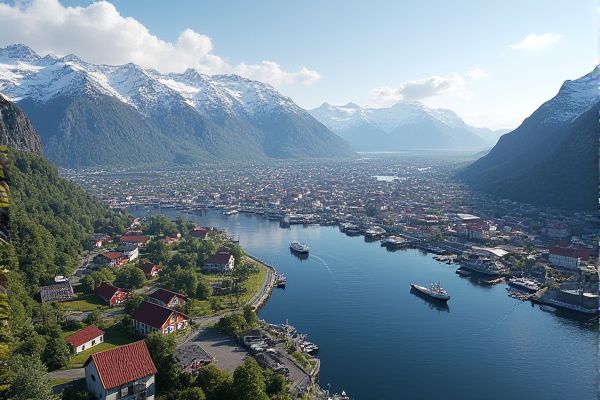
Education system and best schools in Norway: Education system is mostly public and free. Mandatory education lasts 10 years. Curriculum focuses on critical thinking. Emphasis on outdoor learning activities. Norway uses a grading scale from 1-6. Language of instruction is mostly Norwegian. International schools available in major cities. No standardized testing until secondary levels. Strong emphasis on inclusivity and equality. High investment in teacher education programs.
Education system is mostly public and free.
Norway's education system is predominantly public and free, with public universities not charging tuition fees for undergraduate, postgraduate, or doctoral programs to both domestic and international students. This reflects the country's commitment to equality and accessible higher education, making Norway a top choice for many seeking affordable quality education. To learn more about Norway's education system and its unique offerings, visit the NMstudy Unify website for detailed insights and guidance.
Mandatory education lasts 10 years.
In Norway, mandatory education lasts for 10 years, comprising seven years of primary school and three years of lower secondary school, starting when children turn six years old, and is founded on the principles of equity and adapted education for all pupils. For more detailed information about this structure, you can visit the Organisation of the Education System and Its Structure page.
Curriculum focuses on critical thinking.
In Norway, the education system, particularly the new Norwegian curricula implemented from autumn 2020, emphasizes critical thinking. Projects like KriT are developing educational models that use children's literature and news to facilitate critical thinking in primary education.
Emphasis on outdoor learning activities.
In Norway, the education system places a significant emphasis on outdoor learning activities, such as "udeskole," which involves compulsory educational activities outside of school on a regular basis, often in natural and cultural settings, promoting physical activity, well-being, and social relations among students. Nature preschools in Norway also spend a large amount of time in nature, allowing children significant freedom and trust, and organizing daily activities around frequent visits to outdoor reference areas. For more information on this innovative approach, visit Children and Nature Network and learn about their insights on teaching and learning in natural places.
Norway uses a grading scale from 1-6.
Norway does not use a grading scale from 1-6; instead, it uses a graded scale from A to E for pass and F for fail, with A being the highest grade indicating an excellent performance and F indicating a failure to meet minimum academic criteria. For more detailed information, you can visit the Grading and Credit System page of the Western Norway University of Applied Sciences, which provides comprehensive insights into the grading system employed by educational institutions across Norway.
Language of instruction is mostly Norwegian.
The language of instruction in Norwegian schools is primarily Norwegian, ensuring students develop proficiency in their national tongue. From grade 1, English is taught as a mandatory foreign language, reflecting its importance in global communication. As students progress, the curriculum expands to include additional elective foreign languages, which are introduced in grade 8. These options, such as Spanish, German, Russian, or French, provide students the opportunity to broaden their linguistic and cultural horizons. To learn more about this educational framework, you can visit the official website, which offers insights into the diverse language programs offered to Norwegian students.
International schools available in major cities.
Norway offers a range of international schools in major cities, including Oslo, Bergen, Stavanger, and Trondheim. These schools, such as the Oslo International School, British International School of Oslo, International School of Bergen, and International School of Stavanger, provide various international curricula like the International Baccalaureate, British, French, and German curricula, catering to the educational needs of expatriate families and international students.
No standardized testing until secondary levels.
In Norway, there is no standardized testing or grading in primary education; grades are first introduced in mandatory subjects starting in the lower secondary school, which is the Norwegian equivalent of middle school. The education system emphasizes equity, adapted education, and free access to all levels, including higher education and vocational training.
Strong emphasis on inclusivity and equality.
Norway's education system places a strong emphasis on inclusivity and equality, with policies that ensure nearly all students are enrolled in public schools. The system features standardized curricula, delayed introduction of grades until age 13, and integration of students with special needs into regular classrooms. Additionally, the system prioritizes early childhood education, special educational support, and a broad education before specialization. These initiatives collectively contribute to high literacy rates and education levels. To learn more about Norway’s education policies, visit the comprehensive overview on the Learning Routes website.
High investment in teacher education programs.
Norway's education system emphasizes equity and adapted education for all pupils, featuring a structured system from kindergarten to higher education. Managed by the Royal Norwegian Ministry of Education and Research, the system likely includes robust teacher training as part of its comprehensive education policy. Although the provided sources do not specifically detail high investment in teacher education programs, the focus on a cohesive educational approach underscores the importance of quality teaching. For more detailed insights into the system, including organizational structures and policy implementation, one can explore the Organisation of the Education System in Norway.
